Wormery Review & Networking Project
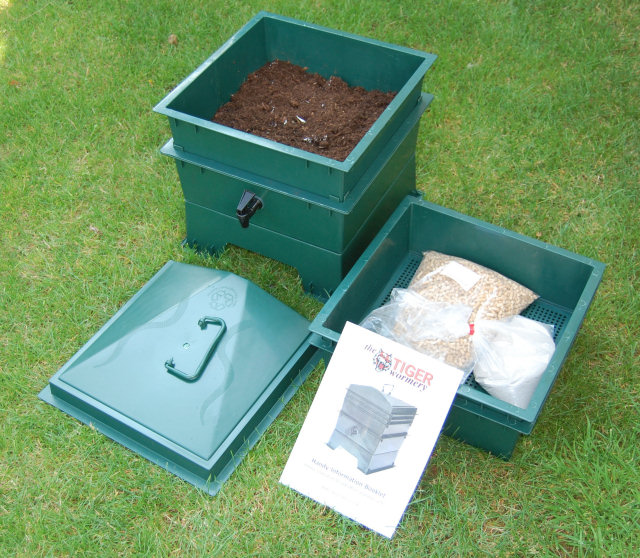
This is an on-going project and a review of our wormery, which we bought from Wormery.co.uk in 2014. It is a design created by Original Organics.
This is the complete set of parts supplied, including a guide on construction and care. There is a bag of 'worm treats' which are compressed paper to help absorb excess moisture.
Why Have A Wormery?
- There is no suitable space in our garden for a full size composting bin, so a small wormery allows us to compost and recycle waste, generating compost for our garden.
- The wormery generates liquid plant feed for our plants.
- As an education for the whole family.
Construction
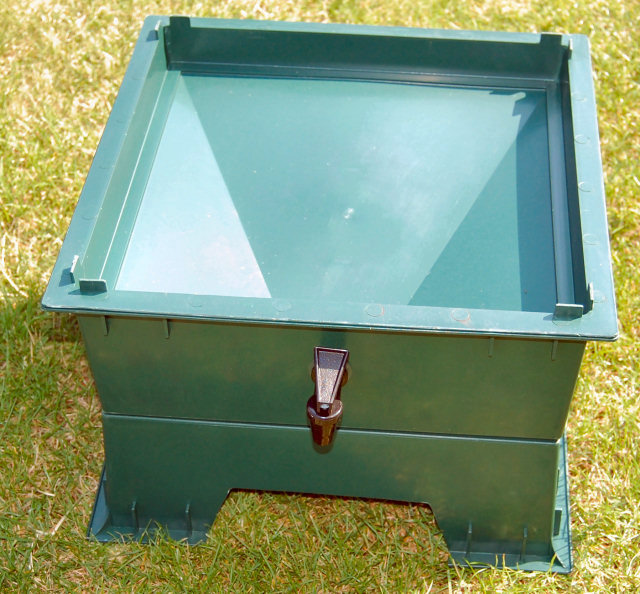
The first part of the construction process involves bolting the stand to the base. The moisture tray is then inserted and the tap fitted to hold these parts together. Liquid plant food collects in this tray and it is important that this tray does not get too full.
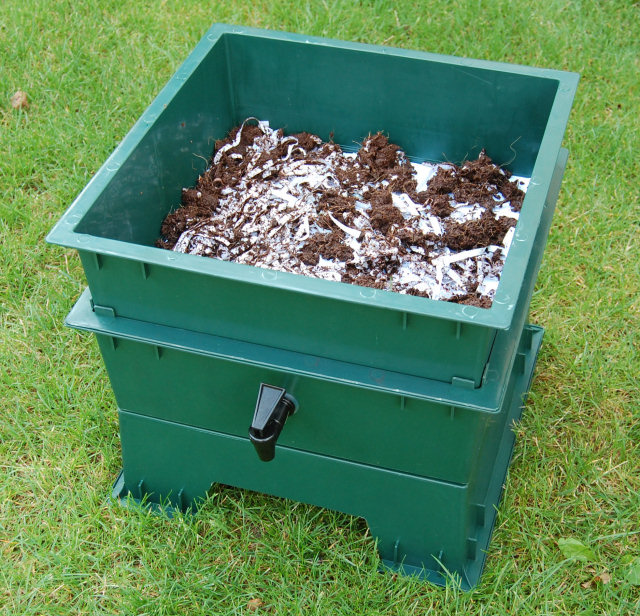
This first 'working' tray is then lined with a sheet of newspaper. This blocks the holes to stop the worms dropping through into the moisture tray. The supplied coir bedding is then mixed with water and shredded paper to form the base layer for the worms.
The Networked Wormery
There are two things we would like to know about our wormery, before they become a problem:
- The fluid level in the moisture tray so that it doesn't get flooded.
- The temperature inside the wormery so that it doesn't get too hot or too cold.
Networking our wormery allows our contextual smart home to collect the data and generate notifications if the moisture tray becomes full or the temperature exceeds the upper and lower limits set.
All of the electronics will be hidden out of sight under the moisture tray, in the base of our wormery. When we first installed our wormery, it was using wireless Z-Wave technology but still required a power source. We have subsequently move it to an Ethernet connected Arduino, which make sit more reliable and we have much greater control over the reporting.
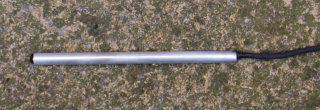
The temperature probe uses a sealed aluminium tube and houses a Dallas DS1820 temperature sensor. You can get these already sealed in stainless-steel but we wanted something longer.
Moisture Tray Level
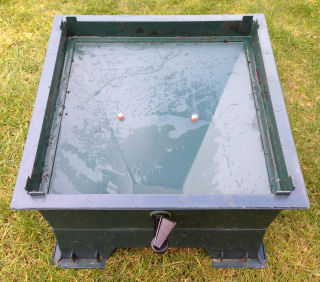
We have mounted two 5mm stainless-steel bolts through the sloping part of the moisture tray and these act as probes to detect when the moisture level is too high.
Power
All of the above components use very little power. We have a waterproof power connecter that supports both the use of an external power supply. Initially, we are using a 12V lead-acid battery with a 12V solar cell to trickle charge it during the day.
In Use
The supplied guide is clear on what to feed the worms and how best to do it. We have located our wormery in a place where it is never in direct sunlight, to ensure it doesn't get too hot.
Early Days
For the first few weeks, just add a small amount of food waste into one corner of the working tray. The worms rely on the food decomposing naturally before they become interested, so some mould is expected.
What To Feed Your Worms
The Tiger worms will eat any dead or decaying organic matter such as peelings, bread, cooked and uncooked scraps, tea bags, egg shells and kitchen paper towels. We are avoiding meat waste as this attracts flies but they can handle this in theory too.
The odd handful of leaves, grass and other garden waste can be used too but, it is best to avoid woody garden waste. Fallen leaves that have been collected are loved by our worms.
Onions, leeks, and citrus fruit tend to be too acidic. Citrus fruit contains a chemical substance (limonene) that is toxic to worms.
Bread can attract mites. We made the mistake of putting some bread in initally and the whole wormery became covered in small mites. We won't be doing it again.
We initially used coffee filter papers but too much ground coffee can make the worms environment too acidic. As we generate lots of these, we now just put them in our garden waste bin
Egg shells are good as they reduce acidity. They are best broken into pieces first.
Large quantities of grass clippings will generate a lot of heat and this can be harmful to the worms. We have added grass clippings to a separate tray above the main tray in use to see how well they like it. We specifically added grass clippings as the winter months approached to provide a bit of warmth for the worms. If they find it too warm, they can stay in the lower tray.
Ongoing Care
The odd handful of the provided lime mix will help keep the acidity down. In colder weather, it is best to keep the wormery out of the frost. We planned to store it in the shed but in practice it is left outside without any real issues.
Tips
- The unused trays can be stored on top of the working tray.
- One of the key things to ensure is that ants can't get into the wormery.
- Heavy rain can let quite a lot of water into the moisture tray, so you must check this regularly to ensure it doesn't get full. This is why we have networked our wormery and monitor the moisture level. The alternative is to put a cover over it.
Learning & Insight
- The amount of garden compost generated is tiny but, the amount of liquid fertiliser for plants is quite significant.
- The wormery needs very little care really. Once a year we empty it out to remove the compost from the lowest tray.
Updates
January 2020
We can't believe it has been so long since we installed our wormery in our garden! It is still going strong and we still have a healthy population of worms. We have changed things slightly. Our wormery now sits higher off the ground and we have a hose from the tap (which is left open), straight into a watering can.
7th August 2014
We have installed and set up our wormery. It is hard to resist the urge to add lots of food and other waste to see the worms in action but, we have resisted. So far we have only added a few dead leaves picked up from our lawn. Some of the worms have crawled up onto the lid and they leave tell-take 'trails' behind and small specks of dirt.
8th August 2014

|
The 'trails' left by the worms in the lid suggest a few have escaped over night (through a small gap where the lid meets the tray) but, the majority seem happy exploring the material in the tray.
|
25th August 2014
The wormery seems to have settled down really well now and looks really healthy. The composting process has well and truly taken hold. As well as some rain water, there is liquid fertiliser appearing in the moisture tray.
We check the moisture tray regularly and often find some soil and a few worms have fallen down through the grating. The number of worms seems to have increased significantly and so has the size of the worms! The main stuff being added to the tray at this time of year is the leaves that have fallen as autumn approaches. These seem to go down particularly well with the worms.
3rd October 2014
The tray with grass cuttings in it was not a good idea. We had placed some of the worms that had dropped through into the moisture tray on top of the grass and all of them appear to have died. We are pretty sure it is too warm for them. We have removed all of the grass clippings.
12th October 2014
Pretty much every day, we are rescuing worms that have climbed down into the moisture tray. To try and prevent this we are going to see if a piece of fine plastic mesh will stop them. It has lots of small holes in it to let moisture through but they are too small for the worms.


|
The mesh is cut to sit inside the tray and will be weighed down by the contents of the tray.
|
18th December 2014
It has been quite a mild winter so far but temperatures have reached -2°C outside. In our shed it has been much warmer though, partly because it runs along the side of our house and some heat leaks through the external wall into the shed. What has surprised us though is how consistent the temperature within the wormery remains. The lowest it has reached is 5°C and the volume of matter in the wormery acts as a buffer to large temperature swings. Typically it is about 2°C above the ambient temperature but changes happen very slowly.



